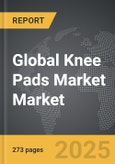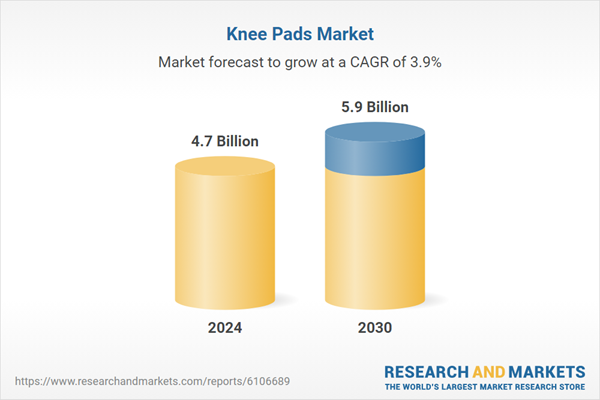Global Knee Pads Market - Key Trends & Drivers Summarized
Why Are Knee Pads Becoming Essential Across Multiple User Segments?
Knee pads have evolved from basic protective gear into essential accessories for a wide range of users spanning industrial workers, athletes, military personnel, and everyday consumers engaged in physically demanding tasks. Their growing importance is driven by increasing awareness of injury prevention, workplace safety regulations, and the demand for ergonomic support during repetitive movement or high-impact activities. In occupational settings such as construction, mining, flooring, plumbing, and landscaping, prolonged kneeling is a common risk factor for joint strain and chronic knee damage. Employers are investing in protective equipment, including high-performance knee pads, to comply with occupational safety standards and reduce worker compensation claims. In sports, knee pads are critical for players in volleyball, basketball, skating, biking, wrestling, and martial arts where frequent falls, tackles, or high-impact landings put the knees at significant risk. The use of knee pads in youth sports has also seen a notable increase, with parents prioritizing protection and long-term joint health for their children. Additionally, military and tactical units utilize knee pads for mobility and defense in rugged terrains, where kneeling and crawling are routine movements. Even in household and DIY tasks, such as gardening or home repairs, more consumers are recognizing the benefit of knee pads for comfort and support. The versatility and growing necessity of knee pads across demographics, professions, and physical activities are fueling a rise in their demand and spurring innovation in design and material science to better meet specific user needs.How Is Technology Transforming Knee Pad Design and Performance?
Technological advancements are playing a central role in redefining knee pad functionality, comfort, and durability, making them more adaptive to the varied needs of different users. Modern knee pads are no longer just foam inserts attached with Velcro straps; they are now highly engineered products that incorporate smart design elements and advanced materials. Innovations include the use of gel inserts, memory foam, high-density polyethylene shells, and moisture-wicking fabrics that offer enhanced shock absorption, pressure distribution, and breathability. Ergonomic shaping and flexible joint segments are being added to allow full range of motion without compromising protection, which is particularly beneficial for athletes and tactical users who require both mobility and stability. Anti-slip surfaces and contoured fittings help keep the pads securely in place, preventing them from shifting during activity. For professionals in construction and manual labor, reinforced caps and abrasion-resistant exteriors extend the lifespan of the pads even in harsh environments. Some manufacturers are introducing smart knee pads with embedded sensors to monitor joint pressure and usage patterns, providing data that can help users avoid overuse injuries. Lightweight and minimalist designs are also being developed to meet the needs of casual users and sports enthusiasts who prioritize comfort and low profile over bulk. Adjustable strap systems, quick-release mechanisms, and multi-size options are improving fit and user experience. Sustainable materials are beginning to appear in new models as environmental consciousness grows, offering recyclable or biodegradable alternatives without sacrificing performance. These technological upgrades are not only enhancing safety and comfort but also making knee pads more appealing and accessible to a broader customer base.What Consumer Preferences and Retail Trends Are Shaping the Market?
Changing consumer preferences and modern retail trends are significantly influencing the global knee pads market, encouraging brands to adapt their offerings and marketing strategies to align with evolving demands. Today's consumers are increasingly looking for products that offer a combination of function, comfort, style, and value. Informed by online reviews, instructional content, and comparison tools, buyers expect knee pads to meet specific performance standards while also fitting seamlessly into their lifestyle or profession. This shift is prompting brands to diversify their product ranges, offering specialized designs tailored for distinct use cases such as industrial labor, professional sports, home fitness, or outdoor recreation. Fashion and aesthetics are becoming more important, especially among younger users and sports communities, leading to the release of knee pads in a variety of colors, patterns, and branded styles. The rise of e-commerce is reshaping the way knee pads are marketed and sold, with digital platforms offering personalized recommendations, video demos, and user testimonials that help consumers make informed choices. Subscription models and bundled packages are gaining popularity among fitness enthusiasts and professionals who require regular replacement due to wear and tear. Additionally, sustainability and ethical sourcing are becoming factors in purchase decisions, pushing companies to emphasize eco-friendly materials and transparent supply chains. Retailers are focusing on enhancing both online and in-store experiences by offering sizing guides, virtual fittings, and loyalty programs. The rise in do-it-yourself home improvement projects and recreational sports since the pandemic has expanded the knee pad customer base beyond traditional user segments. As consumers become more selective and health-conscious, the demand for high-performance, well-designed, and responsibly manufactured knee pads continues to rise, setting new benchmarks for innovation and customer engagement.What Factors Are Driving Growth in the Global Knee Pads Market?
The growth in the global knee pads market is driven by a combination of safety regulations, rising participation in physical activities, and expanding applications across diverse sectors. One of the primary drivers is the increasing focus on occupational health and safety in construction, manufacturing, and logistics, where regulations now require the use of personal protective equipment to minimize injury risk. As industries become more compliance-driven, the procurement of high-quality knee pads is becoming a non-negotiable part of workplace outfitting. In parallel, the global boom in recreational sports and fitness culture is contributing to heightened awareness of joint protection, especially among runners, gym-goers, skaters, and cyclists. The growing popularity of sports among children and adolescents is also fueling demand for youth-specific knee pads that offer comfort, performance, and long-term injury prevention. Military and defense agencies are investing in more advanced protective gear for their personnel, increasing the need for durable, tactical-grade knee protection. The aging population is another important growth factor, as seniors engage in physiotherapy, low-impact exercise, or gardening, and seek joint support to maintain mobility and independence. On the product development front, the availability of cost-effective, ergonomic, and versatile designs is making knee pads more attractive to consumers who previously viewed them as cumbersome or specialized. Globalization of supply chains and improvements in logistics are facilitating wider product availability across markets, including emerging economies where awareness and adoption are rapidly catching up. Marketing efforts focused on safety, wellness, and performance are resonating strongly with target demographics, leading to increased brand loyalty and repeat purchases. Collectively, these factors are creating sustained demand and a fertile market landscape for the continued expansion of the knee pads industry worldwide.Report Scope
The report analyzes the Knee Pads market, presented in terms of market value (US$). The analysis covers the key segments and geographic regions outlined below:- Segments: Distribution Channel (Online Distribution Channel, Offline Distribution Channel); End-Use (Individual End-Use, Industrial End-Use).
- Geographic Regions/Countries: World; United States; Canada; Japan; China; Europe (France; Germany; Italy; United Kingdom; Spain; Russia; and Rest of Europe); Asia-Pacific (Australia; India; South Korea; and Rest of Asia-Pacific); Latin America (Argentina; Brazil; Mexico; and Rest of Latin America); Middle East (Iran; Israel; Saudi Arabia; United Arab Emirates; and Rest of Middle East); and Africa.
Key Insights:
- Market Growth: Understand the significant growth trajectory of the Online Distribution Channel segment, which is expected to reach US$3.8 Billion by 2030 with a CAGR of a 4.7%. The Offline Distribution Channel segment is also set to grow at 2.5% CAGR over the analysis period.
- Regional Analysis: Gain insights into the U.S. market, valued at $1.3 Billion in 2024, and China, forecasted to grow at an impressive 7.3% CAGR to reach $1.2 Billion by 2030. Discover growth trends in other key regions, including Japan, Canada, Germany, and the Asia-Pacific.
Why You Should Buy This Report:
- Detailed Market Analysis: Access a thorough analysis of the Global Knee Pads Market, covering all major geographic regions and market segments.
- Competitive Insights: Get an overview of the competitive landscape, including the market presence of major players across different geographies.
- Future Trends and Drivers: Understand the key trends and drivers shaping the future of the Global Knee Pads Market.
- Actionable Insights: Benefit from actionable insights that can help you identify new revenue opportunities and make strategic business decisions.
Key Questions Answered:
- How is the Global Knee Pads Market expected to evolve by 2030?
- What are the main drivers and restraints affecting the market?
- Which market segments will grow the most over the forecast period?
- How will market shares for different regions and segments change by 2030?
- Who are the leading players in the market, and what are their prospects?
Report Features:
- Comprehensive Market Data: Independent analysis of annual sales and market forecasts in US$ Million from 2024 to 2030.
- In-Depth Regional Analysis: Detailed insights into key markets, including the U.S., China, Japan, Canada, Europe, Asia-Pacific, Latin America, Middle East, and Africa.
- Company Profiles: Coverage of players such as Airush, Best Kiteboarding, Brunotti, Cabrinha, CORE Kiteboarding and more.
- Complimentary Updates: Receive free report updates for one year to keep you informed of the latest market developments.
Some of the 42 companies featured in this Knee Pads market report include:
- 3M Company
- Allegro Industries Inc.
- ALTA Industries
- ASICS Corporation
- Bauerfeind AG
- Blaklader
- Custom LeatherCraft Mfg. LLC (Hultafors Group AB)
- Damascus Worldwide Inc.
- Decathlon S.A.
- Enovis (DJO, LLC)
- Ergodyne (Tenacious Holdings, Inc.)
- FOX Head Inc.
- Honeywell International Inc.
- Klein Tools, Inc.
- LP Support
- McDavid
- Mizuno Corporation
- Mueller Sports Medicine, Inc.
- Nike, Inc.
- Snickers Workwear (Hultafors Group AB)
This edition integrates the latest global trade and economic shifts into comprehensive market analysis. Key updates include:
- Tariff and Trade Impact: Insights into global tariff negotiations across 180+ countries, with analysis of supply chain turbulence, sourcing disruptions, and geographic realignment. Special focus on 2025 as a pivotal year for trade tensions, including updated perspectives on the Trump-era tariffs.
- Adjusted Forecasts and Analytics: Revised global and regional market forecasts through 2030, incorporating tariff effects, economic uncertainty, and structural changes in globalization. Includes historical analysis from 2015 to 2023.
- Strategic Market Dynamics: Evaluation of revised market prospects, regional outlooks, and key economic indicators such as population and urbanization trends.
- Innovation & Technology Trends: Latest developments in product and process innovation, emerging technologies, and key industry drivers shaping the competitive landscape.
- Competitive Intelligence: Updated global market share estimates for 2025, competitive positioning of major players (Strong/Active/Niche/Trivial), and refined focus on leading global brands and core players.
- Expert Insight & Commentary: Strategic analysis from economists, trade experts, and domain specialists to contextualize market shifts and identify emerging opportunities.
Table of Contents
Companies Mentioned (Partial List)
A selection of companies mentioned in this report includes, but is not limited to:
- 3M Company
- Allegro Industries Inc.
- ALTA Industries
- ASICS Corporation
- Bauerfeind AG
- Blaklader
- Custom LeatherCraft Mfg. LLC (Hultafors Group AB)
- Damascus Worldwide Inc.
- Decathlon S.A.
- Enovis (DJO, LLC)
- Ergodyne (Tenacious Holdings, Inc.)
- FOX Head Inc.
- Honeywell International Inc.
- Klein Tools, Inc.
- LP Support
- McDavid
- Mizuno Corporation
- Mueller Sports Medicine, Inc.
- Nike, Inc.
- Snickers Workwear (Hultafors Group AB)
Table Information
| Report Attribute | Details |
|---|---|
| No. of Pages | 273 |
| Published | December 2025 |
| Forecast Period | 2024 - 2030 |
| Estimated Market Value ( USD | $ 4.7 Billion |
| Forecasted Market Value ( USD | $ 5.9 Billion |
| Compound Annual Growth Rate | 3.9% |
| Regions Covered | Global |









